WooCommerce Vs Magento Comparison: Which Is Better?
Besides Shopify or BigCommerce, Magento and WooCommerce are also among those most popular eCommerce solutions. Both two providers bring about multiple features which are needed in creating and managing online stores.
Magento and WooCommerce are both providing open-source, free versions and are based on the PHP programming language. However, each of them has its pros and cons. Magento is more complicated, while WooCommerce is just one of the top plugins of WordPress. When it comes to finding the best eCommerce platform for your store, we normally don’t tell you which to choose but review them carefully so that you can come up with your final decision.
Therefore, in today’s post, we will give you an in-depth comparison between Magento and WooCommerce. Let’s consider which platform meets your demands more and decide your choice!
About Magento
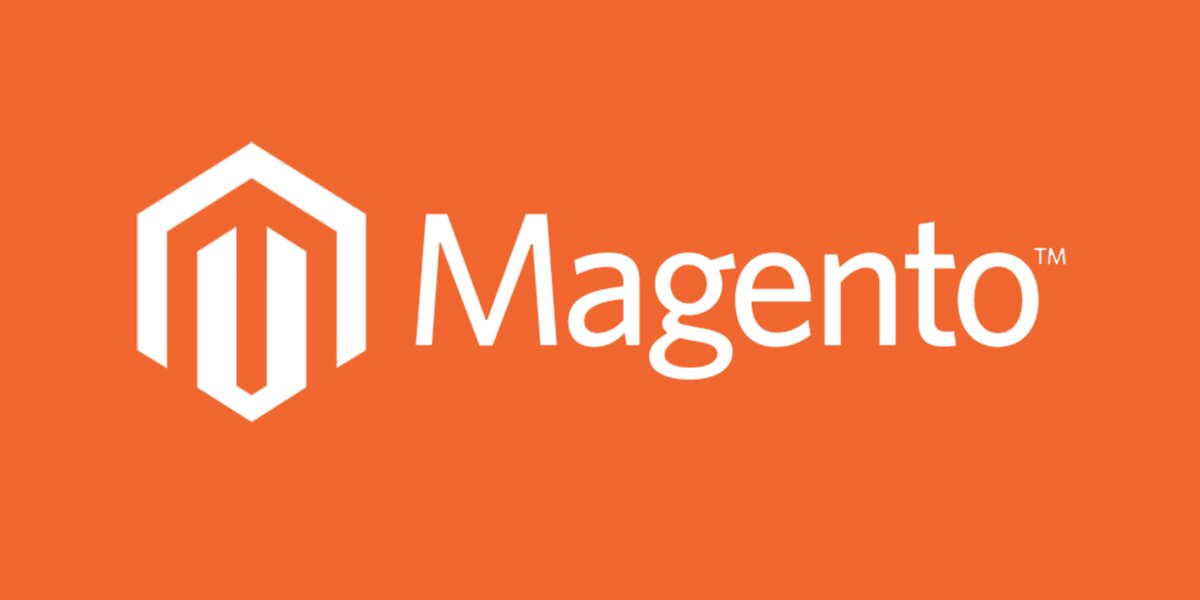
Being launched in 2007, Magento is famous among eCommerce business owners. Magento has brought about many versions and product updates. The platform has multiple noticeable features that others won’t offer, the tool to customize, or an amazing number of integrations. What’s more, Magento will provide both a free open source edition and an Enterprise edition so that its users can choose to host the website on their own or use it as a cloud edition via Magento. One highlight advantage of using Magento is that it’s powerful and robust. However, it seems not to be a strong CMS. Moreover, being an extensive application makes it quite more expensive for small businesses or start-up companies.
About WooCommerce
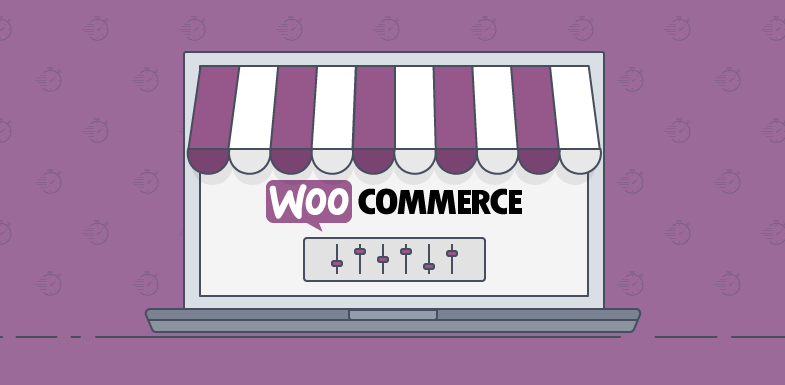
Being launched 4 years after Magento, WooCommerce has also been a familiar platform for eCommerce business owners, especially those who have known WordPress before. In fact, WooCommerce is incorporated in WordPress, which is an open-source software to create websites and blog sites. Despite being a plugin of WordPress, WooCommerce will bring about all features you need to create an online store. If you want more advanced tools, you can still approach its extension system. That’s also why WooCommerce is one of the most lightweight eCommerce platforms, being simple to use for all types of business. However, if you just make use of the core of WooCommerce, it may not be enough. You will need more plugins to reach all functionalities or order management capabilities. This is the biggest drawback of WooCommerce being quite inconvenient to scale in and maintain all these plugins.
WooCommerce Vs Magento Comparison
Ease of use

Magento’s ease of use
As we have mentioned before, Magento is not a user-friendly platform. It claims to be suitable for those businesses that are medium to large online stores or experts in web development. To get used to Magento, you will have to improve your technical knowledge. Even when you only know a little about it, setting up stores with Magento may turn out to be difficult for you. Especially when it comes to modifications or extensions and the theme customization process, users have to spend time and effort learning about them. Normally, though there are many setting guidelines and tutorials, they are for skilled developers so that business owners of Magento have to have others do it for you, which costs an amount of money. However, for those who focus on the scaling time and have the ability to master the platform, the features Magento brings about are really much. If you find it challenging to use Magento, you can also contact Magento experts; they will assist you with Magento development services.
WooCommerce’s ease of use
On the opposite side, WooCommerce targets those business owners who are start-ups, newbies or know nothing about eCommerce. It is because WooCommerce is customizable with users’ WP-Admin dashboard. That means you are allowed to edit your online sites with theme options, adjust the color palettes, insert tools, insert images or videos. What’s more, WooCommerce has many documentation and online tutorials which help users process their stores. Most of them find that the website is so easy to use, especially when they interact with the interface of WooCommerce. Besides, when using WooCommerce, you will be provided a setup wizard leading you easily through every stage of managing websites. You can hardly find a platform that is easier to use than WooCommerce.
Conclusion: For those who have less technical skills, WooCommerce is much more user-friendly than Magento.
Hosting

When creating and managing an online store, business owners will have to leave the question of whether the platform they are choosing provides its own hosting or not. This is important in website security, the speed of page loading process, uptime, etc.
| WooCommerce Hosting | Magento Hosting |
|---|---|
| WooCommerce is not a self-hosted platform. You will have to find a good hosting provider, a domain for you. | Magento’s users can choose open source hosting or cloud hosting since the platform offers both |
| WooCommerce targets building up an online store only | You can choose the domain and hosting provider for your store. After that, you can freely edit and have full control over it |
| The platform works well with any good hosting | When you have Magento control the store for you via cloud hosting, the hosting is also good though you need to rely on its customer support to solve site security or site speed problems |
Conclusion: Magento is the winner in this round since it provides you with two options to choose from while it’s only one when it comes to WooCommerce.
Payment methods
Another important factor to consider is their payment methods.
Magento’s payment methods
When it comes to Magento, the process of payment is easy but quite long. The process will include three stages: going to the Magento marketplace, finding the payment processes or integration extensions you want, and downloading them. On Magento, you will get more and add major payment processors into your online stores. What’s more, the platform provides multi-language support so that you can easily reach international markets.
WooCommerce’s payment methods
In terms of WooCommerce and its payment methods, you can approach Stripe and Paypal, which are the most popular integrations of WooCommerce. However, it doesn’t mean you cannot integrate with other payment methods. If you need, you can also make use of Amazon Pay and Authorize.net. The platform has extensions to support four payment types which are offsite, form, direct, and iframe. Besides, one more thing to remember is that you will be the one who takes care of the integration with payment processors in terms of payment security and eCommerce responsibility.

Conclusion: Magento is suitable for large businesses targeting international markets, while WooCommerce’s process of payment is easy and quick, suitable for all businesses. It might be a tie here!
Performance
Performance means the speed of website loading. It will rely on the business itself and the hosting provider. When it comes to eCommerce, if your online site wastes customers’ time on loading, they won’t hesitate to leave your store since there are multiple businesses out there providing the same products as you. Let’s see which platform has a better performance.
Magento’s performance
Because the core of performance depends on the speed and the availability conducted on the back-end, let’s look at some measurements taken on them.
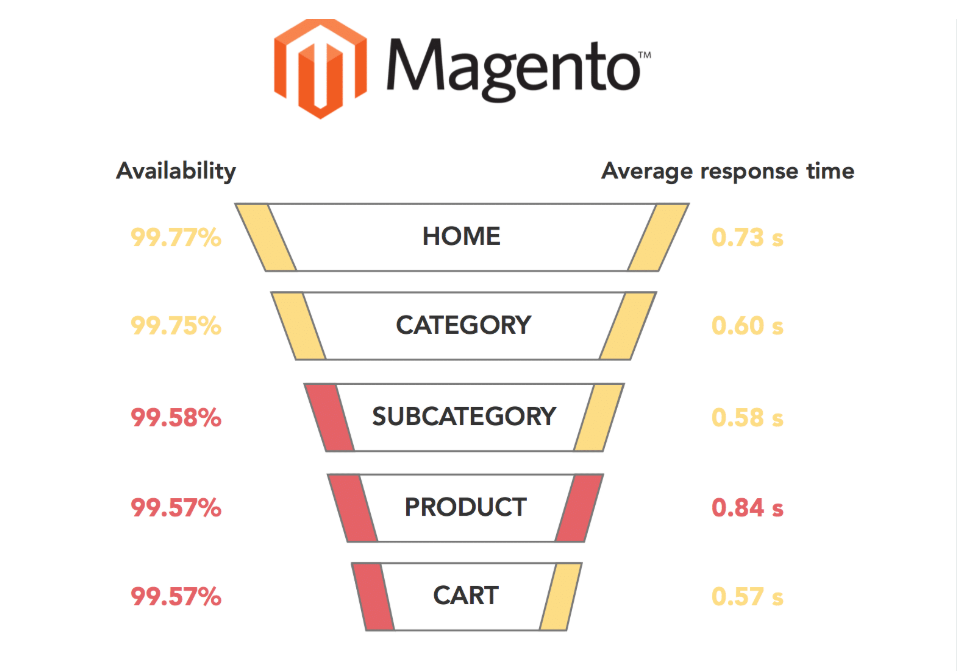
According to the chart, the average availability rate of Magento is up to 99,71%. This is pretty high, but the speed is not as fast as expected. In particular, the page loading time is 665 milliseconds. The reasonable amount of time taken to load is 568 milliseconds. The speed of Magento is just a little bit slower, but it’s because of its complicated machine and it is not a big deal also.
Luckily, skilled developers are working to improve the performance of Magento via Magento 2.0 and over.
WooCommerce’s performance
Similar to Magento, WooCommerce’s availability rate is pretty high. However, its speed is noticeably slower, which is 776 milliseconds and 1.32 seconds to reach the cart page. The WooCommerce machine is not as complex as that of Magento but the time is slower, which results in an inconvenient feeling while using. In fact, the possibility of accessing WooCommerce is still satisfying in some cases.
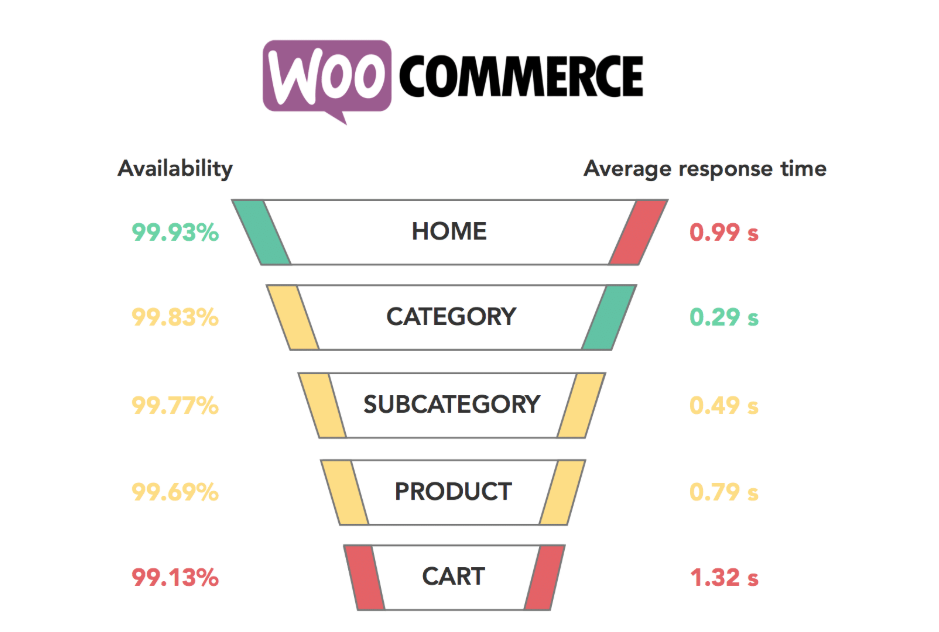
Conclusion: So, it’s easy to see that Magento has better performance since its page loading speed is a bit quicker.
Scalability
Scalability is also important to take into account when choosing an eCommerce platform.
Magento’s scalability
When it comes to Magento, you will have to scale your online site on your own. Or else, you need to spend money hiring a skilled Magento developer to handle this task. However, being a resource-intensive solution, scaling your website may be quite costly for some small businesses. To be more specific, when scaling it yourself, you have to upgrade to a dedicated server first. Then, you have to face problems related to cloud hosting services, managing backups, optimization for caching, or other technical issues. Our best advice is to have someone do it for your business.
WooCommerce’s scalability
In terms of its competitor, WooCommerce, you still have to suffer from the same problems, and we also recommend you should hire an experienced developer to do it for you. However, it is not as expensive as Magento. When your business develops, let’s move to WordPress hosting solutions like WPEngine or Liquid Web. They are concierge WordPress hosting companies so you can not only scale your store to meet eCommerce goals but also avoid spending too much.
Conclusion: WooCommerce is the winner in this round. Unless you are a master in scaling, we think you should hire an expert or developer with a lower cost from WooCommerce.
Security

The ability to protect your online store and customers’ data is vital for long-term goals since it directly affects your reputation. Similar to performance, security depends on businesses’ actions. Saving yourself from the exploitation of cyberattacks is essential to maintain your reliability and retain your customer base.
WooCommerce’s security
WooCommerce provides its enterprises with an SSL certificate. It has to maintain its own security measurements since there are no highlighted security issues via WordPress. If your store doesn’t rely on setting up extensions to grow, there’re hardly any problems. However, if your business does, third parties are involved in your process and security issues may occur.
Magento’s security
Magento has the Security Scan Tool for its users to increase the security of their eCommerce sites. In general, Magento is highly secured. The security patches are dedicated. Besides, it offers more built-in security extensions to help prevent yourself from cross-site scripting attacks and clickjacking exploits.
Conclusion: Both platforms are secured enough. However, if you are about to grow with more advanced extensions, Magento is a better choice.
Product management
In terms of product management, users of WooCommerce can make use of both physical and digital products. In order to set up new products, you just need to take some simple steps. If you have used WordPress before, managing products brings no difficulties. Also, you can approach WooCommerce’s plugins like Product Add-Ons to expand the functionality of your store in case you are in need. However, to use them, you have to buy them!
When it comes to Magento, you don’t need to spend extra money on buying the paid features provided by WooCommerce. Some of them are product reviews, grouped products, listing, advanced pricing rules, or product personalization. Although it goes along with a steeper learning curve, Magento’s set of features is worth your time.
Conclusion: If your business is small and you have no demand for setting up new features in your store, WooCommerce is a better choice since the process will surely be quicker and simpler. But in case your business needs more features without paying, go for Magento. So, in this round, it’s a tie.
Pricing
When selling online, the price of an eCommerce platform must be your priority to choose. Both solutions provide users with a free option. However, the actual cost needed to have good control over your online site is different. Let’s see which platform is cheaper.
WooCommerce’s pricing
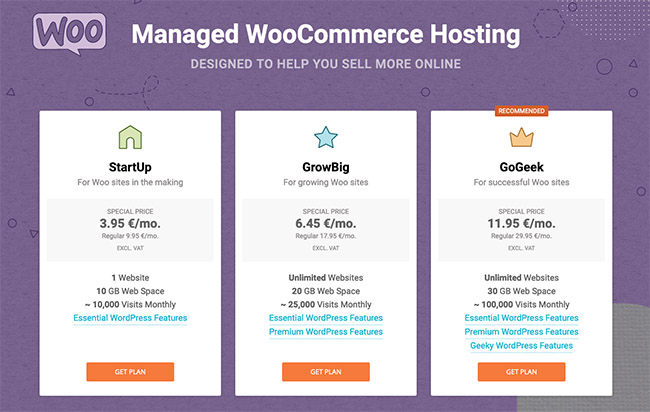
Being an open-source platform, WooCommerce offers a free plan for all WordPress users with basic eCommerce features.
In case you need to grow your site more, you need to buy a domain and web hosting for WooCommerce, which is about $10 to $250 per year. In fact, besides web hosting, you have to pay for many other functionalities to gain full control over your site. That’s why you can’t know exactly the cost needed to use WooCommerce. The more features you buy, the more expensive it is.
Some of the necessary features you will have to purchase are domain names, the SSL certificate, which is from $9 per month, theme and website design, which is from $50 to $100, or plugins and extensions, which are from $25.
You can also choose not to buy them and make use of essential features and free services. They are enough for small businesses with low budgets.
Magento’s pricing
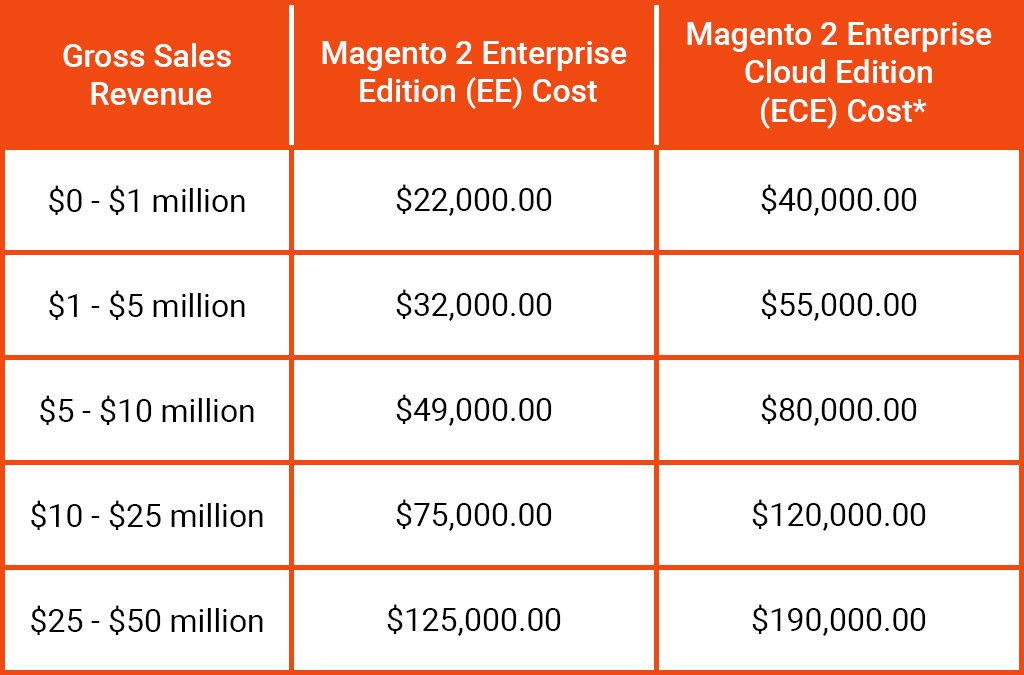
Being a self-hosted solution, Magento also offers a free plan with basic functions. Different from WooCommerce, Magento has three editions for you to choose from:
Magento Community which is the free edition. It is totally free to download and install. It is kinda similar to WooCommerce in this plan since you will have to pay money for buying hosting services which are from $10. This edition only includes basic features so you have to buy more items such as paid extensions which are from $10 to $500, themes which cost about $0 to $200, the domain, which is from $10 to $500, or hosting which is about $10.
Magento Enterprise is a premium paid edition of Magento. This plan brings about multiple additional features to suit huge businesses with complicated machines, large workloads, and complex demands. Some of these features may be advanced inventory, warehouse management, in-depth admin roles, business intelligence tools. To make use of this plan, the pricing will depend on the Gross Sales Revenue every year of your business. If your business gains $0 to $1,000,000 GSR per year, the price is about $22,000. For companies that have the annual GSR is $25,000,000 to $50,000,000, the price can be up to $125,000.
Finally, Magento Enterprise Cloud is similar to the Magento Enterprise plan but it’s in the cloud. Already including hosting, this edition is more expensive than other plans. However, it is well managed, automated and includes many noticeable features like optimal security, full customization, or web storefront scalability. To use this edition, you have to pay about $40,000 to $190,000 based on your annual GSR.
Conclusion: It’s easy to see that WooCommerce is cheaper. However, only when you just need that small number of features to manage your store will you find it affordable. Buying more advanced features to scale up the business turns into more expensive. Whereas, Magento has more features with pricing plans to choose from. So, in this round, Magento is the winner.
Plugins
Plugins are functionalities or tools integrated into stores to improve the operation of their websites. Both platforms are popular with a massive number of plugins.
| Magento’s plugins | WooCommerce’s plugins |
|---|---|
| A large community of developers, agencies, and freelancers | Able to use WordPress plugin for WooCommerce stores |
| Magento has both free and paid extensions | WooCommerce has both free and paid extensions |
| Magento Marketplace has about 6000 extensions for all majors like accounting & finance, marketing, sale, payment & security, content & customization, site optimization, reporting & analytics, and customer support. | WooCommerce has thousands of paid plugins and about 55,000 free plugins and themes for majors like product type, store management, marketing, payments, shipping, enhancement, and subscription. |
| In case there are no plugins that can solve your problem, contact a developer to custom a new one for only you | Able to link your site with third-party services like CRM software, email marketing automation solutions, or payment gateways |
| Qualified community with skilled developers and businesses | Costly to have more extensions |
| Multiple advanced features | Complicated machine to theming |
| eCommerce first product | Not suitable for regular users |
Conclusion: It’s totally a tie here since both platforms bring about multiple plugins and extensions to meet almost all of your demands. Since some of them are paid, consider carefully installing only the ones you need the most.
SEO and Marketing

To sell online, what you need to care about is reaching your customers, increasing sales. That is marketing. SEO, content, marketing are the priorities of any online business. Now, let’s look at the SEO and Marketing features of Magento and WooCommerce
WooCommerce’s SEO and Marketing
In terms of SEO, users of WooCommerce will get SEO compatibility and writing blogs functionalities similar to WordPress since it is a plugin of WordPress. This platform is suitable for those who focus on content and SEO. You don’t have to approach any writing blogs function since you have had a complete one. With the help of WooCommerce, creating content is never easier. By utilizing shortcodes, you can add pages, write blog posts, install add-ons, and add other extra elements.
What’s more, you have the chance to connect with an affiliate program via free extensions. Thanks to these plugins, you can follow up emails, social media, discount codes, newsletter subscriptions, or more.
Magento’s SEO and Marketing
Magento is a self-hosted solution, so it brings about optimization features to increase the output. Magento will provide you with a huge feature set in terms of SEO to increase your rankings in the search engine’s results. These features are more advanced than WooCommerce, and you can easily make use of them even when you know little about SEO and content. When using Magento, it’s easy to access redirects, canonical tags, customize permalinks, or meta tags. Users of Magento can also make use of its Marketing Menu to manage promotions, communications, SEO, and content.
When it comes to marketing features, Magento’s toolset is amazing with MAP (minimum advertised price), landing page for categories, customer groups, managing newsletter tool, wish lists sent by email, multi-tier pricing for quantity discounts.
The only thing to take note of is that users of Magento have to use a custom blog extension since its blog features are not provided in Magento default
Conclusion: As you can see, WooCommerce is suitable for those who concern about SEO and content, while Magento has features of both SEO and Marketing. So, Magento wins this round again.
Customer support

Finally, let’s come to the customer support round to see which platform brings about better solutions for their users’ technical issues. One similarity of the two solutions is that they all have a large customer base, so their community is huge enough to share problems and support for each other.
WooCommerce’s customer support
There must be fewer technical issues for those who are using WooCommerce due to its ease of use. If you do have, you can rely mainly on its community which is open 24/7. Additionally, you can get help from its support resources or hiring a skilled developer to help you out.
Magento’s customer support
The support will depend on which edition you are in. In terms of the free plan - Magento Community Edition, users can get support from the forums and a huge community. When it comes to the Enterprise edition, users can get help from email and live support. Besides being a member of Magento Forums and Magento Community, you can also be a member of the Magento partner agency or read its user guides and technical sheets for help. Also, you can get help from experts and developers who are very dedicated and ready to assist you.
Conclusion: With the free plan, you hardly find better support than the community. For bigger technical issues, Magento seems to bring about more support. Anyway, we suggest you should rely on a developer or expert to help you solve the problems.
Which platform is better for your business in 2021?
WooCommerce’s Pros and Cons
| WooCommerce’s Pros | WooCommerce’s Cons | |:———————————————————————————————————————-:|:—————————————————————————————————————-:| |The top plugin of WordPress, you can get all features of WordPress | Requires extra plugins to get full control and ideal functionality, which is difficult and costly | |Simple to use | Limited advanced features | | Lower learning curve | Even harder for those who don’t use WordPress since they have to get started with two platforms at the same time | | It’s free to set up a store (not including the web hosting fee) | Premium themes and extension costs can add up quickly. | | Lower cost of owning | Buggy sites by bad developers and businesses | | Most suitable for businesses focusing on content more than eCommerce such as those selling eBooks, podcasts, and more. | Slow site-loading page | | You can approach extensive documentation to get solutions or directly contact the support team | One version only for WooCommerce without no enterprise edition | | Multiple free plugins | Hard to scale if it is a large site | | Multiple themes to choose | Weak database machine which is difficult for high order volume and scalability | | Huge open source community | Weak product data capabilities for complex catalogs | | The platform has extensions to support four payment types which are offsite, form, direct, and iframe. | | | Integrations with Google Analytics using an extension | | | SSL support | |
Magento’s Pros and Cons
| Magento’s Pros | Magento’s Cons |
|---|---|
| Suitable for all types of businesses | High cost for small businesses |
| Well-designed scalability | Not easy to use, requiring skilled developers |
| Many versions including | Weak CMS capabilities, not suitable for businesses focusing content |
| Enterprise, Open Source, Cloud, and other products | Higher maintenance overhead |
| Qualified community with skilled developers and businesses | Costly to have more extensions |
| Multiple advanced features | Complicated machine to theming |
| eCommerce first product | Not suitable for regular users |
| MVC framework for scalability | |
| B2B eCommerce functionalities | |
| Ability to manage many stores | |
| Strong product data capabilities | |
| Suitable for complicated catalogs | |
| Order management is quick | |
| Multiple payment methods and shipping methods | |
| Robust promotion capabilities | |
| Ability to control large stores | |
| Guest checkout is turned on by default. | |
| Quick check-out process |
Final verdict
Via the comparison, you can see that Magento wins most of the round. However, whether it is the best platform for you depends on your demands. If you are a beginner or a small-scale store, the choice must be WooCommerce since it’s simple to use, cheap to set up. But if your businesses require more than that, Magento might be more suitable since it has more out-of-the-box features, high security, and high performance.
For us, Magento may be ideal since it fits all types of business while WooCommerce does not. All businesses will dream of a future when they grow more and more. So, for a long-term goal, Magento is a better choice.
Conclusion
As we have mentioned earlier, we won’t tell you what to choose but give you all things you need to know about two platforms so that you can decide the most suitable for yourself. If your business has a large catalog, complicated demands of B2B, integration, or other features, Magento is your best match. But if your store is focusing on content more than eCommerce features, WooCommerce is a better one.
One more thing to remember is that the pricing of Magento is nearly two times more than WooCommerce. Therefore, let’s list out your most important requirements and how much you are ready to pay for an eCommerce platform before deciding the solution to use.
Hopefully, in this post, we have given you enough knowledge on both platforms via an in-depth comparison to help you realize which one is better for your business. If you find this article interesting, share this with your friends. We also have many helpful topics so remember to visit us for more.
Thank you, and wish you can find your best eCommerce platform!





